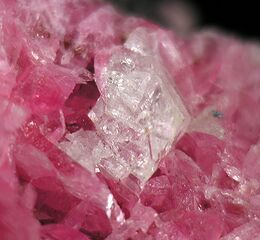Chemistry:Cahnite
| Cahnite | |
|---|---|
 Cahnite on rhodonite | |
| General | |
| Category | Borate minerals |
| Formula (repeating unit) | Ca2B[AsO4](OH)4 |
| Strunz classification | 6.AC.70 |
| Crystal system | Tetragonal |
| Crystal class | Disphenoidal (4) (same H-M symbol) |
| Space group | I4 |
| Identification | |
| Color | Colorless to white |
| Cleavage | Perfect On {110} |
| Tenacity | Brittle |
| Mohs scale hardness | 3 |
| |re|er}} | Vitreous |
| Diaphaneity | Transparent |
| Density | 3.156 g/cm3 |
| References | [1] |
Cahnite (Cahnit in German, Cahnita in Spanish, Канит in Russian[3]) is a brittle white or colorless mineral that has perfect cleavage and is usually transparent. It usually forms tetragonal-shaped crystals and it has a hardness of 3 mohs.[4][5] Cahnite was discovered in the year 1921.[3] It was named Cahnite to honor Lazard Cahn (1865–1940), who was a mineral collector and dealer.[4] It is usually found in the Franklin Mine, in Franklin, New Jersey,[5][4] but has also been found in Japan [6] as well as in the Vallerano quarries in Rome, Italy.[7] The geological environment that it occurs in is in pegmatites cutting a changed zinc orebody.[3][4][5] The chemical formula for cahnite is Ca2B[AsO4](OH)4.[5][8][9] It is made up of 26.91% calcium, 3.63% boron, 25.15% arsenic, 1.35% hydrogen, and 42.96% oxygen. It has a molecular weight of 297.91 grams.[5] Cahnite is not radioactive.[4] Cahnite is associated with these other minerals: willemite, rhodonite, pyrochroite, hedyphane, datolite, and baryte.[3]
References
- ↑ Mineralienatlas
- ↑ Warr, L.N. (2021). "IMA–CNMNC approved mineral symbols". Mineralogical Magazine 85 (3): 291–320. doi:10.1180/mgm.2021.43. Bibcode: 2021MinM...85..291W.
- ↑ 3.0 3.1 3.2 3.3 Mindat data sheet for Cahnite.
- ↑ 4.0 4.1 4.2 4.3 4.4 Mineral Data sheet for Cahnite.
- ↑ 5.0 5.1 5.2 5.3 5.4 Database entry from Mineral Collecting.[yes|permanent dead link|dead link}}]
- ↑ Article stating that veins of cahnite were found in Okayama Prefecture.
- ↑ "Cahnite". https://www.mindat.org/min-851.html.
- ↑ Database entry for Cahnite from Mincryst.
- ↑ Database entry for Cahnite from Japanese database.
 |

